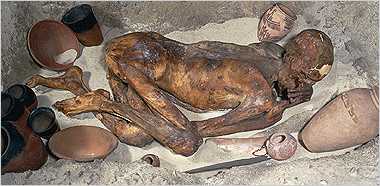|
Embalming
The body is taken to a tent which is known as "ibu" ("the place of purification"). Embalmers wash the
body with palm wine, then rinse it with Nile water. A cut is then made on the left side of the body and most of the internal
organs are removed. The liver, lungs, intestine and stomach are washed and put in natron which will help dry them out. The
heart is left inside the body becuase the Egyptians believed iit to be the centre of intelligence and the man will need to
use his heart in the afterlife. One process that is familiar to most people is that a long hook is used to
pull the dead body's brain through his nose. Now, the body is covered and stuffed with natron. Forty days later, the body
is washed again. Then it is covered with oils to keep the elasticity in the skin. The organs are dehydrated and wrapped in
linen. They are then returned to the body. The body is stuffed with sawdust and other dry materials. The body is again covered
with oils and is now ready to be wrapped.

|
| Earlier ancient Egyptians would bury the dead it small pits...this is the damage it did to the dead. |
Canopic Jars
Canopic jars played a significant role during the mummification process. Each of
the jars were used to hold and protect a single organ. The two organs that were not placed in the canopic jars were the heart
and the brain. The heart remained inside the body becuase it was believed to be the center of souls, intelligence and
emotions. The brain was removed, but thrown out because it was belived to be useless.

There were four jars, which meant four organs. One jar
had the head of a jackel named Duamutif, who protected the stomach. There was Hapi (with the head of a baboon) who held
onto the lungs. The intestines were preserved inside a canopic jar named Quebehsnuf, who has the head of a falcon. Lastly,
Imsety the human protected the liver.
|